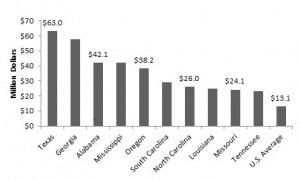Farm Harvests Contribute to Forestry Too
With fall in the air, harvest season is upon us. Revenues generated from farming include not only crops and livestock, but also forest products. The USDA, when compiling farm income statistics, classifies forest products produced on farms as either timber, firewood, maple syrup, Christmas trees, or decorative products.
The total value of forest-based production on U.S. farms in 2012 was $653.2 million. Admittedly, forests contribute only a small amount to total farm wealth, less than 1.0%, but this is still an income source with substantial value on its own merits. For example, the revenues from forest products produced on farms alone approached the total value for delivered timber in the state of North Carolina, which was $730.6 million in 2012.
From the figure below, North Carolina ranked sixth nationally in on-farm forest income at $26.0 million. This was almost double the $13.1 million for the average state.

Based on the relative contributions of timber to farm wealth, even a modest increase in timber management and production could easily double on-farm forest income. This would be akin to adding another North Carolina to the U.S. forest economy. It is also likely this could be accomplished without significantly affecting the production of other farm commodities.
As forest biomaterial markets expand, or new products become commercially available, this may be a supply source that becomes increasingly worthy of consideration. However, logistical challenges do exist and would need to be overcome.
Sources: USDA Economic Research Service’s report on Farm Income and Wealth; North Carolina State Extension Forestry’s 2012 Income of North Carolina Timber Harvested and Delivered to Mills.
- Categories: